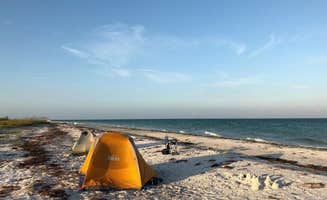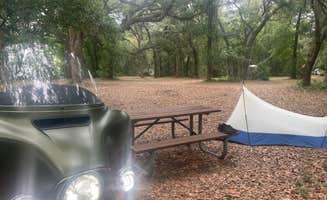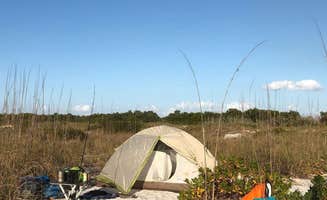Primitive camping near Odessa, Florida consists primarily of undeveloped sites in conservation areas and preserves, with most requiring boat transportation or offering limited vehicle access. The region sits at an average elevation of 50 feet above sea level, with subtropical climate conditions making fall through spring the most comfortable camping seasons. Summer camping brings temperatures routinely exceeding 90°F with high humidity and frequent afternoon thunderstorms.
What to do
Wildlife viewing and photography: Shell Key Preserve offers exceptional wildlife observation opportunities, with one camper noting, "We saw sting rays, a baby turtle, many different birds & other wildlife within 5 minutes of parking the boat." The island's isolated nature creates natural wildlife viewing corridors uncommon in developed areas.
Paddling exploration: Anclote Key Preserve State Park Campground provides excellent paddling access to multiple islands. According to one visitor, "Once you arrive take time to explore each area- Anclote Key, North Anclote Bar, South Anclote Bar and Three Rooker Island." The area covers approximately 11,000 acres with multiple paddling routes connecting the island chain.
Night sky observation: With minimal light pollution on the barrier islands after day visitors depart, stargazing becomes exceptional. One camper at Shell Key described the experience: "You can enjoy most water activities as well as what nature has to offer from bird and dolphin watching to fishing and hiking the almost 2 mile long island." Clear nights offer unobstructed views of constellations across the entire sky dome.
What campers like
Off-season solitude: October through April offers fewer insects and more comfortable temperatures. One camper at Shell Key Preserve shared, "The key is right across from South Beach at DeSoto so you're bound to hear some loud music from motor boats during the day, but it clears out and feels super remote by evening." Weekday camping significantly increases chances of isolation.
Water access on two sides: The barrier islands feature Gulf beaches on one side and intercoastal waterway on the other. A camper explained, "On the west coast of the island is the blue waters of the Gulf of Mexico, while only footsteps away is the lush waters of the Intercoastal waterway." This dual-water access allows for both calm and wave conditions within minutes of each campsite.
Abundant fishing opportunities: The convergence of freshwater and saltwater systems creates productive fishing zones. During cooler months, wade fishing becomes particularly productive around the preserves, with one camper mentioning, "You have easy access to the waterways for exploring and fishing." A Florida Saltwater Fishing license is required for all anglers 16 and older.
What you should know
Complete self-sufficiency requirement: Island camping requires carrying all supplies. One camper at Anclote Key advised: "There are no provisions offered on the island, so be prepared to bring your own water and supplies. Make sure all food is secured." Most sites require 2-3 gallons of water per person per day.
Beach camping challenges: Finding suitable tent sites among vegetation requires careful selection. A camper explained, "You can find some sandy spots tucked into the vegetation every so often along the 'beach', but you won't fit a large tent in these areas." Sand stakes or sand anchors become essential for secure tent setup.
Strict environmental regulations: Upper Hillsborough Water Management Area and other preserves enforce strict waste management protocols. One camper noted the lack of facilities: "The lack of trash cans was surprising. Just take your trash with you, leave no trace, and it was an enjoyable and free experience!" All waste must be packed out, including used toilet paper at most locations.
Tips for camping with families
Weather planning considerations: Summer brings intense heat, humidity and afternoon thunderstorms that can make island camping challenging with children. One visitor recommended, "We kayaked out from Anclote river park and stayed two nights on the island. There are no amenities so we packed everything we would need in the kayak." Consider fall and winter camping for more moderate conditions.
Age-appropriate paddling distances: For families with younger children, consider the paddling distance carefully. A camper explained the approach to Shell Key: "Park off the Pinellas Byway before you get to the DeSoto bridge, paddle between Summer Resort Key and Sister Key and you're there. One of the easiest island paddles out there - just a little over a mile."
Alternative mainland options: For families seeking easier access with similar natural experiences, mainland options provide more amenities. According to one visitor to Upper Hillsborough: "Large open area with great shade trees, no water, privy. Easy pull through for RV. Tent spots. Fire rings." These sites require less logistical planning while still offering natural surroundings.
Tips from RVers
Limited RV access near water: Most waterfront primitive camping is inaccessible to RVs, requiring separate transportation arrangements. For RVers seeking primitive camping experiences, Upper Hillsborough offers "primitive, easy pull through sites" with enough clearance for modest-sized vehicles on maintained road surfaces.
Space constraints and leveling: RV campers should note the uneven terrain at available locations. One camper described Upper Hillsborough as having "easy pull through for RV" but others mentioned the need to park on side roads when designated areas were full, noting: "Didn't find the Main Camping area. Parked in one of the side roads."




